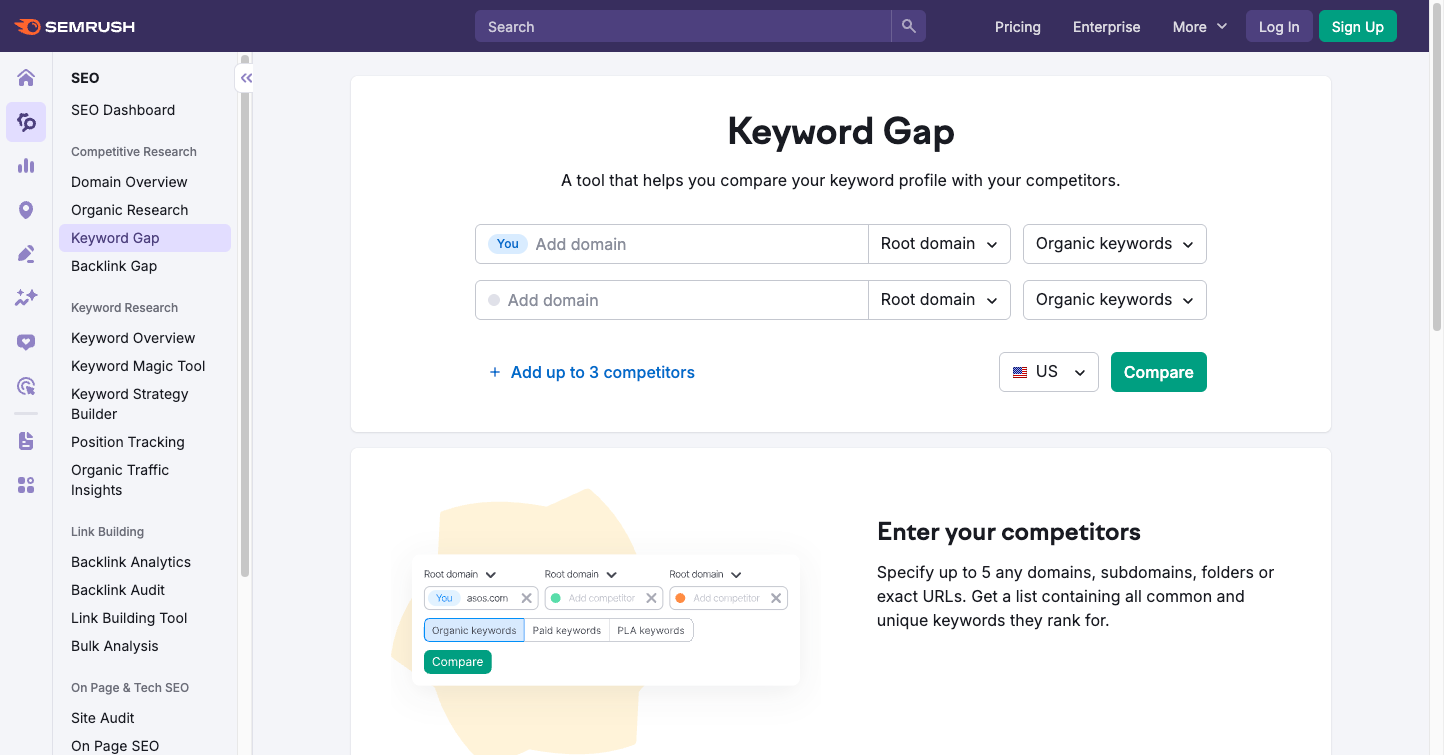How to Perform a Competitive Content Analysis
It's time to tackle that content analysis head-on. Because what if I told you that a proper competitive content analysis could unlock the exact keywords your audience is searching for, reveal content gaps your competitors haven't spotted, and show you precisely how to outrank them?
With 46% of B2B marketers expecting their content marketing budget to increase in 2025, the competition isn't slowing down. Meanwhile, only 29% of B2B marketers rate their content strategy as extremely or very effective. Don't be part of that majority creating "meh" content.
Intrigued? Let's dive into how to perform a competitive content analysis that'll transform your content strategy from guesswork into a data-driven powerhouse. ⬇️
What is competitive content analysis?
Competitive content analysis is the systematic examination of your direct competitors' content strategies, from their messaging and content formats to their SEO tactics and distribution channels. It all comes down to understanding why their content works, where it fails, and how you can exploit those insights to dominate your market.
The anatomy of competitive content analysis
Strategic content evaluation: Analysing competitors' content themes, publishing frequency, content depth, and messaging consistency to understand their strategic priorities.
SEO performance assessment: Examining which keywords competitors rank for, their SERP feature ownership, backlink strategies, and technical optimisation approaches.
Content format analysis: Understanding which content types drive the most engagement for competitors—blog posts, videos, infographics, podcasts, or interactive tools.
Distribution channel mapping: Tracking how competitors promote their content across social media, email, partnerships, and paid channels.
User engagement patterns: Studying how audiences interact with competitor content – what gets shared, commented on, and converts.
Content gap identification: Spotting topics, keywords, or content formats that competitors haven't covered or have covered poorly.
The fundamental misunderstanding most marketers make
Your SEO competitors might be completely different from your business rivals.
Business competitors vs. SEO competitors: A critical distinction
Your business competitors sell similar products to similar customers. But your SEO competitors? They're anyone ranking for the keywords you want to target. That lifestyle blogger ranking #1 for your target keyword isn't trying to steal your customers – but they're definitely stealing your traffic.
Consider this example: If you're a B2B software company targeting "project management tools," your business competitors might be Asana, Monday.com, or Trello. But your SEO competitors could include:
Personal productivity bloggers reviewing project management apps
Business consultants writing about team efficiency
Freelance platforms comparing collaboration tools
University business departments publishing project management guides
Each of these represents a different type of content competitor with different strengths, weaknesses, and strategies.
Types of competitive content analysis
1. Domain-level analysis Examining competitors' entire content libraries to understand their overall strategy, content themes, and market positioning.
2. Page-level analysis Deep-diving into specific high-performing competitor pages to understand what makes them successful and how you can create something better.
3. Keyword gap analysis Identifying terms your competitors rank for that you don't, revealing content opportunities you're missing.
4. Content gap analysis Finding topics, questions, or content formats that competitors haven't addressed adequately.
5. SERP feature analysis Understanding which competitors dominate featured snippets, People Also Ask boxes, and other SERP features.
6. Distribution strategy analysis Mapping how competitors promote and distribute their content across different channels.
What competitive content analysis reveals
Content strategy blind spots: Topics your competitors consistently miss or cover superficially.
Keyword opportunities: High-value search terms with manageable competition levels.
Content format gaps: Types of content (video, interactive tools, downloadables) that could differentiate your brand.
Seasonal content patterns: When competitors ramp up content production and which topics they prioritise.
Audience preferences: What content formats and topics generate the most engagement in your niche.
Technical advantages: SEO optimisation opportunities competitors have overlooked.
Distribution weaknesses: Channels or platforms where competitors have little to no presence.
Step 1: Identify your real competitors
Before you can analyse anyone, you need to know who you're actually up against. This is where most people mess up – they analyse their business competitors instead of their content competitors.
Finding your direct competitors
Your direct competitors offer similar products or services to the same audience. These are the obvious ones. But don't stop there.
Discovering your SEO competitors
Your SEO competitors are websites ranking for the same keywords you want to target. They might be completely different businesses, but they're stealing your organic traffic.
Here's how to find them systematically:
Method 1: Manual SERP analysis
Search your target keywords in Google
Note the top 10 results for each
Look for patterns – who appears consistently?
Method 2: Use competitor analysis tools Tools like Ahrefs, Google Keyword Planner, or Semrush can identify websites that rank in the top 10 for the same keywords as your target terms.
Method 3: Industry publication analysis
Check which sites rank for industry-specific terms
Monitor trade publications and thought leadership content
Analyse who's consistently appearing in industry roundups
Creating your competitor matrix
Once you've identified 5-10 competitors, categorise them:
Direct business competitors: Same products/services, same audience
SEO competitors: Different business, same keywords
Content competitors: Similar content themes, different focus
Emerging competitors: New players gaining traction
Step 2: Deep-dive competitor keyword research
This is where the magic happens. You're not just looking at what keywords your competitors rank for – you're uncovering the entire keyword landscape they've mapped out.
Advanced keyword gap analysis
Use Semrush's Keyword Gap tool to find keywords quickly. Add your domain and the domains of up to four competitors, then click "Compare" to run the analysis.
But don't stop at the basic export. Here's how to dig deeper:
1. Segment by keyword intent
Informational keywords (how-to, guide, what is)
Commercial keywords (best, review, comparison)
Transactional keywords (buy, discount, free trial)
2. Analyse keyword clusters Look for groups of related keywords that suggest content themes. For example, if competitors rank for "email marketing software," "email automation tools," and "email campaign management," there's a clear cluster around email marketing solutions.
3. Identify seasonal patterns Use tools like Google Trends to understand when competitors ramp up content around specific topics. This reveals timing opportunities.
The SERP feature opportunity audit
58% of Google's results contain a People Also Ask type of SERP feature according to Moz. Here's how to leverage this:
Featured snippets analysis:
Identify keywords where competitors own featured snippets
Analyse the format (paragraph, list, table)
Note content gaps in existing snippets
People Also Ask exploitation:
Extract questions from PAA boxes
Create content that answers these questions more comprehensively
Target question-based long-tail keywords
Local pack opportunities: If relevant to your business, analyse who's dominating local search results and why.
Step 3: Content format and strategy deep-dive
Now for the detective work. You're examining not just what your competitors write about, but how they structure, format, and distribute their content.
Comprehensive content audit methodology
Content type analysis: Identify the types of content they create – blog posts, infographics, videos, or a mix. Create a spreadsheet tracking:
Blog post frequency and topics
Video content themes and platforms
Downloadable resources (ebooks, guides, templates)
Interactive content (calculators, quizzes, tools)
Case studies and customer stories
Content depth assessment:
Average word count by content type
Use of multimedia (images, videos, infographics)
Internal linking strategies
External source citations and authority building
Publishing pattern analysis
43% of marketers publish content several times a week, with at least weekly posting considered essential for engagement. But frequency isn't everything. Track:
Publishing schedule consistency
Peak engagement days/times
Content promotion timing
Seasonal content strategies
Content promotion strategy analysis
Social media distribution: YouTube is the top social media traffic driver for 98% of leading SaaS companies, followed by Facebook (96%) and LinkedIn (78%).
For each competitor, analyse:
Platform-specific content adaptation
Posting frequency per platform
Engagement rates and response strategies
Use of hashtags and trending topics
Email marketing integration:
Lead magnet strategies
Newsletter content themes
Email sequence structures
Content gating decisions
Step 4: Advanced content gap analysis
This is where you shift from observer to strategist. You're not just noting what exists – you're spotting what's missing and what could be better.
The comprehensive gap identification framework
1. Keyword gaps Performing a keyword gap analysis to find terms competitors rank for that you don't helps you fill content gaps at the site level.
Use this systematic approach:
Export competitor keywords you don't rank for
Filter by search volume and relevance
Categorise by buyer journey stage
Prioritise by business impact potential
2. Topic depth gaps Content that isn't thorough misses essential subtopics or doesn't provide enough information about them.
For each major topic in your niche:
Compare competitor coverage depth
Identify missing subtopics
Note outdated information opportunities
Spot areas lacking expert insights
3. Content format gaps If competitors focus heavily on text content but your audience prefers video, that's a format gap worth exploiting.
4. User experience gaps Analyse competitor content for:
Page load speed issues
Mobile optimisation problems
Poor internal linking
Weak calls-to-action
SERP analysis for content optimisation
SERP analysis helps you pinpoint gaps in your competitors' strategies – such as overlooked topics, under-optimsed keywords, or weak content in high-ranking positions.
The systematic SERP evaluation process:
Search intent alignment check
Do top results match user intent?
Are there misaligned results you could outrank?
Content quality assessment
Depth and comprehensiveness analysis
Accuracy and recency evaluation
User experience quality check
Technical optimisation review
Page speed performance
Mobile-friendliness
Structured data implementation
Step 5: SEO performance and technical analysis
Content quality means nothing if it's not discoverable. This step reveals why some competitor content ranks while other (potentially better) content doesn't.
Advanced SEO metrics analysis
Organic traffic assessment: Gathering monthly organic search traffic numbers on your competitors can help you benchmark your own brand against them.
Use tools like Semrush Domain Overview to track:
Total organic traffic trends
Traffic per content piece
Seasonal traffic patterns
Geographic traffic distribution
Backlink profile analysis: Evaluate the backlink profile of their high-performing content. Backlinks are citations from other websites, and a strong backlink profile can significantly boost SEO performance.
Focus on:
Linking domain authority
Anchor text diversity
Link acquisition strategies
Broken link opportunities
Technical SEO competitive audit
Core Web Vitals comparison:
Page loading speed analysis
Largest Contentful Paint (LCP)
First Input Delay (FID)
Cumulative Layout Shift (CLS)
Content structure optimisation:
Header hierarchy analysis (H1, H2, H3 usage)
Meta description optimisation
Internal linking strategies
Schema markup implementation
Step 6: Content distribution and promotion analysis
Creating brilliant content is only half the battle. How are your competitors getting their content in front of audiences?
Multi-channel distribution strategy analysis
Social media amplification: In 2025, there are estimated to be 5.42 billion total social media users worldwide, with an average person using 6.83 different social networks per month.
Track competitor strategies across:
Platform selection and prioritisation
Content adaptation per platform
Community engagement tactics
Influencer collaboration strategies
Email marketing integration:
Content newsletter strategies
Lead nurturing sequences
Segmentation approaches
Personalisation tactics
Paid promotion analysis:
Social media advertising spend patterns
Google Ads content promotion
Sponsored content partnerships
Retargeting strategies
Community and partnership leverage
Industry partnership analysis:
Guest posting strategies
Podcast appearances
Webinar collaborations
Cross-promotional activities
Community engagement:
Forum participation
Industry group involvement
Comment section management
User-generated content encouragement
Step 7: Creating your competitive analysis framework
Time to turn all this research into actionable strategy. You need a systematic approach to organise your findings and prioritise opportunities.
Building your comprehensive analysis dashboard
Create a detailed spreadsheet with these columns:
Competitor information:
Company name and URL
Business model and target audience
Content team size (if discoverable)
Publishing frequency
Content strategy:
Primary content types
Average content length
Content themes and topics
Seasonal content patterns
SEO performance:
Estimated monthly organic traffic
Top ranking keywords
Featured snippet ownership
SERP feature presence
Social media presence:
Active platforms
Follower counts and engagement rates
Content promotion strategies
Community building approaches
Gap opportunities:
Missing keyword targets
Content depth improvements
Format innovation possibilities
Distribution channel gaps
Prioritisation framework
Not all content gaps are worth pursuing. Use this framework:
Impact vs. effort matrix:
High impact, low effort: Quick wins (prioritise first)
High impact, high effort: Strategic initiatives (plan carefully)
Low impact, low effort: Fill when resources allow
Low impact, high effort: Generally avoid
Business alignment scoring: Rate each opportunity (1-5) on:
Relevance to your target audience
Alignment with business goals
Resource requirements
Competitive advantage potential
Step 8: Advanced content creation strategies
Analysis paralysis is real. 61% of B2B marketers expect their organisations' investment in video to increase in 2025, but many still struggle to act on competitive insights.
Strategic content creation priorities
1. Fill the biggest gaps first Target high-volume keywords where competitors rank poorly or don't rank at all. Even improving on one or two gaps gives you a good shot of leapfrogging your competition on Google's first page.
2. Improve on existing winners Look at your own content for gaps, you can improve it… and reap the rewards. Find competitor content that ranks well but could be better.
3. Test new formats If everyone's writing blog posts, try:
Interactive calculators or tools
Video series or tutorials
Downloadable templates
Audio content or podcasts
Content optimisation methodology
The 10x content framework: For each piece you create, ensure it's:
More comprehensive than competitors
More current and accurate
Better designed and formatted
More actionable and practical
Better optimised for user experience
SERP feature optimisation: Align your content format with the snippet style currently ranking for your target keyword:
Paragraph snippets: Use target query as subheading, answer immediately in concise paragraph
List snippets: Use numbered lists for sequential information, bullet points for unordered
Table snippets: Present information in simple tables with clear headings
Step 9: Tools and technology stack
The right tools can make or break your competitive analysis efforts. Here's a comprehensive breakdown of the best options.
Premium tool comparison
Semrush: Semrush's Keyword Magic Tool offers the most comprehensive set of features for keyword research, from keyword discovery to competitive analysis.
Comprehensive competitive analysis toolkit
Strong PPC insights
Content gap analysis features
Social media monitoring
Ahrefs: Ahrefs provides an in-depth competitor analysis through its Site Explorer tool, which allows you to track your competitors' backlink profiles, organic search performance, and top-ranking pages.
Superior backlink analysis
Excellent keyword difficulty accuracy
Strong content explorer features
Reliable traffic estimates
SpyFu: SpyFu shines in competitor analysis, especially in the PPC space. With SpyFu, you can easily see which keywords your competitors are bidding on, their ad budgets, and their most successful ad copies.
Strongest PPC competitor analysis
Historical data going back years
More affordable pricing
User-friendly interface
Free tool arsenal
Google's free toolkit:
Google Search Console for your own data
Google Trends for seasonal insights
Google Keyword Planner for basic keyword research
Google Analytics for traffic analysis
Additional free resources:
Answer The Public for question-based keywords
Ubersuggest (limited free version)
Keywords Everywhere browser extension
MozBar for on-page analysis
Tool selection framework
Consider these factors when choosing:
Budget constraints:
Free tools for basic analysis
Single tool for focused needs
Tool suite for comprehensive analysis
Team size and expertise:
Beginner-friendly options (SpyFu, Ubersuggest)
Professional-grade tools (Semrush, Ahrefs)
Enterprise solutions for large teams
Specific use cases:
PPC focus: SpyFu or Semrush
Backlink analysis: Ahrefs
All-in-one solution: Semrush
Budget-conscious: Mix of free tools
Step 10: Measuring and optimising your competitive advantage
You've done the research. You've created the content. Now how do you know if it's working?
Key performance indicators (KPIs)
Traffic metrics:
Organic traffic growth month-over-month
Traffic from target keywords
SERP feature capture rate
Click-through rate improvements
Engagement metrics:
Time on page vs. competitors
Bounce rate comparison
Social shares and engagement
Email sign-up rates
Competitive metrics:
Keyword ranking improvements
SERP feature wins
Content gap closure rate
Market share growth
Ongoing competitive monitoring
Monthly reviews:
Keyword ranking changes
New competitor content analysis
SERP feature updates
Social media performance shifts
Quarterly deep-dives:
Comprehensive competitor landscape review
Strategy adjustment based on market changes
Tool performance evaluation
Team training and development
Continuous improvement framework
Performance review process:
Analyse what worked and what didn't
Identify new opportunities and threats
Adjust strategy based on data
Implement improvements and test
Market evolution tracking:
New competitor emergence
Industry trend shifts
Algorithm update impacts
Technology advancement effects
Ready to dominate your competition?
Competitive content analysis reveals the exact roadmap your competitors have laid out for you, complete with all their mistakes highlighted in red.
The content marketing landscape is more competitive than ever, but that also means the opportunities for those who approach it strategically are greater than ever. Your competitive analysis is your secret weapon – use it wisely.
Want to transform your competitive insights into conversion-driven copy that actually ranks? My copywriting and brand strategy services help ambitious brands turn competitive analysis into market-dominating content strategies. From verbal brand identity to SEO-optimised website copy that converts, I combine strategic thinking with compelling words that work.






